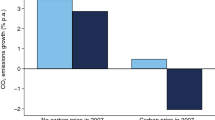Abstract
Gasoline “divorcement” regulations restrict the integration of gasoline refiners and retailers. Theoretically, vertical integration can harm competition, making it possible that divorcement policies could increase welfare; alternatively, these policies may reduce welfare by sacrificing efficiencies. This paper attempts to differentiate between these possibilities by estimating a reduced form equation for the real retail price of unleaded regular gasoline. I find that divorcement regulations raise the price of gasoline by about 2.6¢ per gallon, reducing consumers' surplus by over $100 million annually. This finding suggests that current proposals to further separate gasoline retailing from refining will be harmful to gasoline consumers.
Similar content being viewed by others
References
Anderson, R., and R. Johnson. 1999. “Antitrust and Sales-Below-Cost Laws: The Case of Retail Gasoline.” Review of Industrial Organization 14: 189–204.
Barron, J., and J. Umbeck. 1984. “The Effects of Different Contractual Arrangements: The Case of Retail Gasoline Markets.” Journal of Law & Economics 27: 313–28.
Barron, J., M. Loewenstein, and J. Umbeck. 1985. “Predatory Pricing: The Case of the Retail Gasoline Market.” Contemporary Policy Issues 3: 130–39.
Bonanno, G., and J. Vickers. 1988. “Vertical Separation.” Journal of Industrial Economics 36: 257–65.
Borenstein, S., and R. Gilbert. 1993. “Uncle Sam at the Gas Pump: Causes and Consequences of Regulating Gasoline Distribution.” Regulation: 63–75.
Borenstein, S., A. Colin Cameron, and R. Gilbert. 1997. “Do Gasoline Prices Respond Asymetrically to Crude Oil Price Changes?” Quarterly Journal of Economics 112: 305–39.
Borenstein, S., and A. Shepard. 1996. “Dynamic Pricing in Retail Gasoline Markets.” RAND Journal of Economics 27: 429–51.
Coase, R. 1937. “The Theory of the Firm.” Economica n.s. 4: 386–405.
Cone, K., and D. Dranove. 1986. “Why Did States Enact Hospital Rate-Setting Laws?” Journal of Law & Economics 29: 287–302.
Dougher, R., and T. Hogarty. 1991. “The Impact of State Legislation on the Number of Retail Gasoline Outlets.” American Petroleum Institute Research Study #062.
Energy Information Administration. 1999. Petroleum Marketing Annual. Washington: Government Printing Office.
Espey, M. 1996. “Explaining the Variation in Elasticity Estimates of Gasoline Demand in the United States: A Meta-Analysis.” Energy Journal 17: 49–60.
Espey, M. 1998. “Gasoline Demand Revisited: An International Meta-Analysis of Elasticities.” Energy Economics 20: 273–95.
Fenili, R., and W. Lane. 1985. “Thou Shalt Not Cut Prices! Sales-Below-Cost Laws for Gas Stations.” Regulation: 31–35.
Goldstein, L., R. Gold, and A. Kleit. 1998. “Divorced From the Facts: Retail Gasoline Divorcement Redux.” Oil & Gas Journal (November 9): 27–34.
Hart, O., and J. Tirole. 1990. “Vertical Integration and Market Foreclosure.” Brookings Papers on Economic Activity: 205–86.
Hausman, J. 1978. “Specification Tests in Econometrics.” Econometrica 46: 1251–71.
Honeycutt, T. C. 1985. “Competition in Controlled and Uncontrolled Gasoline Markets.” Contemporary Policy Issues 3: 105–39.
Klein, B., R. Crawford, and A. Alchian. 1978. “Vertical Integration, Appropriable Rents, and the Competitive Contracting Process.” Journal of Law & Economics 21: 297–326.
Klein, B. 1988. “Vertical Integration as Organizational Ownership: The Fisher Body-General Motors Relationship Revisited.” Journal of Law, Economics, & Organization 4: 199–213.
Lanning, J., M. Morrisey, and R. Ohsfeldt. 1991. “Endogenous Hospital Regulation and its Effects on Hospital and Non-Hospital Expenditures.” Journal of Regulatory Economics 3: 137–54.
Lin, A. Loh et al. 1985. “State Gasoline Consumption in the USA: An Econometric Analysis.” Energy Economics 7: 29–36.
Mallela, P., and B. Nahata. 1980. “Theory of Vertical Control With Variable Proportions.” Journal of Political Economy 88: 1009–25.
Monteverde, K., and D J. Teece. 1982a. “Supplier Switching Costs and Vertical Integration in the Automobile Industry.” Bell Journal of Economics 13: 206–13.
Monteverde, K., and D. J. Teece 1982b. “Appropriable Rents and Quasi-Vertical Integration.” Journal of Law & Economics 25: 321–28.
Ordover, J. et al. 1990. “Equilibrium Vertical Foreclosure.” American Economic Review 80: 917–42.
Reiffen, D., and M. Vita. 1995. “Is There New Thinking on Vertical Mergers?” Antitrust Law Journal 63: 917–41.
Rey, P., and J. Stiglitz. 1995. “The Role of Exclusive Territories in Producers' Competition.” RAND Journal of Economics 26: 431–51.
Salinger, M. 1988. “Vertical Mergers and Market Foreclosure.” Quarterly Journal of Economics 103: 345–56.
Savvides-Gellerson, E. 1987. The Effects of State `Below-Cost' Selling Laws on Retail Prices of Motor Gasoline.” American Petroleum Institute Research Study #043.
Shepard, A. 1990. “Pricing Behavior and Vertical Contracts in Retail Markets.” American Economic Review (Papers and Proceedings) 80: 427–31.
Shepard, A. 1993. “Contractual Form, Retail Price, and Asset Characteristics.” RAND Journal of Economics 24: 58–77.
Slade, M. 1998. “Strategic Motives for Vertical Separation.” Journal of Law, Economics, & Organization 14: 84–113.
Spengler, J. 1950. “Vertical Integration and Antitrust Policy.” Journal of Political Economy 58: 347–52.
Tirole, J. 1988. The Theory of Industrial Organization. Cambridge: MIT Press.
Westfield, J. F. 1981. “Vertical Integration: Does Product Price Rise or Fall?” American Economic Review 71: 334–46.
Author information
Authors and Affiliations
Rights and permissions
About this article
Cite this article
Vita, M.G. Regulatory Restrictions on Vertical Integration and Control: The Competitive Impact of Gasoline Divorcement Policies. Journal of Regulatory Economics 18, 217–233 (2000). https://doi.org/10.1023/A:1008150819999
Issue Date:
DOI: https://doi.org/10.1023/A:1008150819999




